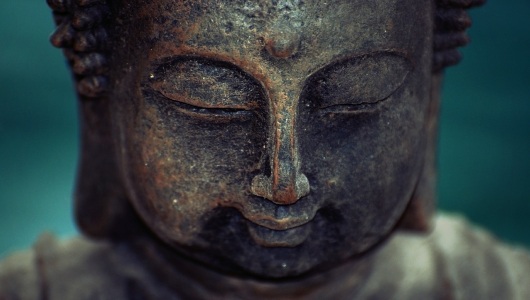
Meditation is nothing but a choice, a conscious choice, to change the mind.
The practice is designed to help the mind be able to grow, mature, and look at circumstances in different ways.
No matter how disciplined a mind might be, meditation can help to create a stronger foundation for the day.
Bringing a higher sense of self-awareness into every situation, even lifelong habits and patterns can be changed with the practice of meditation.
What is Buddhist meditation? It is a way to begin a pursuit of Enlightenment – something that may be called Nirvana.
What makes Buddhist meditation so unique is that there isn’t just one set of rules to follow.
The Buddha taught that each type of meditation was specifically designed to help overcome a certain set of problems or create a specific mental state.
The two forms of meditation that are most commonly associated in the non-Buddhist world to this practice are the Loving Kindness Meditation and the Mindfulness of Breathing.
Is Buddhist Meditation Important to Practice?
It is absolutely important. We all may try to do our very best to be “good” or “perfect” on a daily basis, but each person has a certain set of internal desires that will cause them to make unconscious choices that aren’t necessarily good for themselves or the world around them.
Someone who gets angry when an accident happens may promise themselves that they won’t be as angry the next time around, yet 45 minutes later when the milk drops out of the refrigerator, they will get angry again.
Practicing meditation helps to develop the energy and awareness that is needed to change these habits.
Instead of being reactionary to every situation, people can become proactive with their inner being by understanding themselves and who they are as a core person.
A greater understanding of these core natures then allows a practitioner of Buddhist meditation to have more overall control over whatever life can throw at them.
Meditation can be dangerous to practice. There are many things in life that can be dangerous when they are not practiced properly.
Drinking a cup of coffee might make you feel more awake, but if you took in 1 gram of powdered caffeine, it would probably kill you. If you get behind the wheel of a vehicle when you haven’t had enough sleep or had a couple of drinks too many, then you are at the wheel of a potentially deadly machine. Meditation is no different than this.
Buddhist meditation is not an instant cure for the mental disorders or conditions that some people may be suffering from right now. It will not cure depression or panic disorders (although who knows). Meditation can actually trigger a panic attack because it forces a person to look inward at their fears at some point.
Treatment to prepare for meditation instead of jumping right into it is sometimes a better course of action to take.
Why Isn’t Meditation Working For Me?

Meditation isn’t something that you can just pick up in a day. It requires patience, consistency, persistence, and engagement at a core level.
If these four components are not part of the daily meditation routine, then the full benefits of the practice will not make themselves apparent in a life until they are.
The most common mistake that people make when it comes to meditation is to eliminate the consistency. There are several ways that meditation can become inconsistent, sometimes in ways that are not even realized.
- Time for meditation is not regularly scheduled every day, so a daily routine of meditation is never established.
- Different types of meditation are attempted [mindfulness, loving kindness, deep breathing] every day instead of sticking to one form of meditation to make it perfect.
- Different techniques for meditation are applied on a routine basis from different teachers because it seems like a great idea.
Seeking out advice about meditation is an excellent course of action to take. The problem that many people have is that they have taken a little bit out of one philosophy, another little bit from another, and then taken advice from the internet to fuse together their own form of meditation using several different bits of advice.
That just doesn’t work.
You can’t bake cookies by just randomly throwing a bunch of ingredients into a mixing bowl to create a cookie dough. There needs to be precise ingredients with precise measurements to create a proper cookie dough that will bake into something delicious when it is given enough time in the oven. The same is true with meditation.
Taking advice from several different teachers to create a personal meditation routine rarely works. It may provide some benefits, but it will not provide a maximum level of assistance. When used appropriately and practiced in a sensible way, meditation is not dangerous at all.
How to Practice the Mindfulness of Breathing
There are four basic steps to the practice of Mindfulness of Breathing: posture, place, practice, and problems.
Finding a comfortable position of this form of meditation is important, but one must also be able to create clear breathing pathways so that the true benefit of meditating can be achieved.
A great posture to use when trying this meditation is to sit with legs folded, a pillow underneath you for comfort, and your back straight. Keep your hands in your lap in a natural place and close your eyes.
For those who may have hip, joint, or back problems, using a chair to take a seated position may be more suitable. This is fine for the Mindfulness of Breathing. As long as you can keep your back straight, the benefits can be experienced in either form of posture.
To find the right place for meditating in this fashion, you will want to seek out a room or environment that will be fairly quiet and not contain a lot of distractions. If you are disturbed, then the meditation benefits may not be as complete as desired.
The first thing that tends to happen once you’ve achieved posture and place is that the mind will begin to wander. You may begin thinking of the chores in the house that need to get done, plans for the future, or even what you might want to cook for dinner that night.
These are natural thoughts. Identify them and allow them to float away. Draw your attention to the pattern of your breathing. In and out… and count your breathing if necessary to help your mind stay in the present moment.
Thoughts are likely to keep trying to intrude into this process. Do your very best to not get frustrated by this. It happens to even the most dedicated of Buddhist meditation practitioners.
Just bring your attention back to your pattern of breathing. Every time you do this, you will be creating a pattern that will eventually lead you to a natural place where the mind automatically dismisses intruding thoughts for you because it has become used to the practice.
Immediate results can be felt, but true increases in concentration and focus take time to develop. Strength comes with regular time investments and in return, you’ll achieve deeper levels of peace and calm.
How To Practice Loving Kindness Meditation

If you have become successful at the Mindfulness of Breathing, then you are ready to try other forms of Buddhist meditation.
Many choose to start the practice of Loving Kindness meditation because it fits in naturally with the goals that many have with life.
The feelings that one is able to develop for others, especially those that they have allowed into their intimate inner circles, will be enhanced and increased. Friendships become easier to form because individuals are more secure about themselves and who they are at a core level.
Instead of harboring a grudge, it becomes much easier to forgive and move on – especially from unintended wrongs.
It is incredibly easy to forgive in the right mindset.
Loving Kindness meditation helps the mind be able to focus its energy and project it outward. This projection has an effect on everyone every day, whether you notice it not.
The next time you are out in public, take a look at the attitudes of the people around you. When someone is angry, those that engage this person become agitated or angry themselves. When someone engages in friendly conversation, those around this person tend to become less defensive and are more willing to respond.
When love is shown to others, love is also projected outward. It’s like a big Pay It Forward line at a Starbucks drive-thru except that the payment is in a loving attitude of kindness that is being shared. Love is contagious.
Why Doesn’t Loving Kindness Meditation Succeed More Often?
The ancient observation that you must love others as much as you love yourself isn’t very well practiced today.
It isn’t because people don’t actively try to love those around them. There are many wonderful acts of loving kindness that are practiced every day. The fault is a lack of focus inward. When 100% of the love we have to give is focused outward and 0% is focused inward, then the art of Loving Kindness is not being practiced.
That’s why this Buddhist meditation begins with a focus inward. As you begin a session of this meditation, which should happen about three times per week after you’ve achieved noticeable benefits from the Mindfulness of Breathing, the first thing that you must do is grant yourself permission to be happy, calm, and peaceful.
Whatever you feel is important to grant yourself here is appropriate as long as it involves yourself. A removal of hatred, protection from danger, or better health are commonly requested of oneself.
After you’ve given yourself permission to be well, the next step is to think of your loved ones and wish them well. Sometimes it isn’t loved ones that come to mind – it is your enemies. The people you avoid if at all possible.
You must also wish these people well in order for Loving Kindness to succeed. If you claim to love others as much as you love yourself, yet hate your enemy, then you are not being honest with yourself and this form of Buddhist meditation will struggle to find success.
Is It Time to Begin Meditating Today?

What is Buddhist meditation? It could be the answer you’ve been seeking to find to gain more personal control over your life.
You do not need a teacher to begin meditating, but having a personal guide who can hold you accountable during your beginning days can be quite helpful in establishing this new routine.
If you do select a teacher, do so carefully. A teacher must be balanced and knowledgeable about the teachings of Buddha to be able to guide you in these and other forms of Buddhist meditation.
As you begin, you may notice right away that there is a peaceful, almost therapeutic effect that occurs after a session has been completed. This is because mediation helps to restore the balance that a person has over their life.
The insights that Buddha taught about the human mind are able to help people achieve true calmness and peace today just as they were able to do so in the ancient world.
By being able to take control of your foundations, you will be able to effectively meditate starting today. Be able to take control of your body through posture and breathing. Explore your feelings, validate them in a neutral way, and allow them to be present without needing them to be experienced in the moment.
In doing so, the mind will begin to control its mental contents and you will be able to see more clearly than perhaps ever before.
Buddhist meditation can be practiced by kids and adults alike. It can be practiced as a family.
Buddha’s meditation technique was simple: find a quiet place, get into a comfortable position that allows you to breathe, and then begin exploring the issues that are creating an unbalance in life.
Begin that practice today and you may just find that meditating regularly is an amazing experience.
Read next:
———————————————————————————-
Image from Pixabay
Image courtesy of gubgib at FreeDigitalPhotos.net (Love Love Love)



